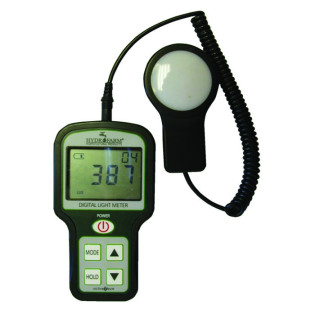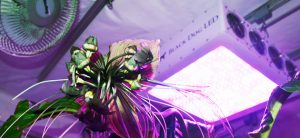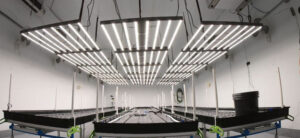
Are you aware of just how effective your grow light is? If you are growing indoors, you need to understand how to measure your light with a PAR meter.
Light is one of the most prominent factors in how your plants grow, and so it is important to constantly be testing your light output.
There are other ways to measure light, such as lumens and lux meters, but these won’t give you the same useful information, and have sort of become outdated.
We're going to tell you everything you need to know about measuring your grow light, including how to actually use a PAR meter, and some limitations these may have.
Then, we will give you some tips on how to increase your lights effectiveness. First, let’s cover why lumens and lux don’t cut it these days.
Why lumens and lux aren’t the best way to measure light
In the past, lumens and lux meters have been used to measure light for plants, but we have since learned that these are not the best indicators of how well a light will grow a plant.
Lumen is total light produced within the range of the human visual response but tells us very little about a light’s effectiveness in horticulture.
This is especially true when light reaches the end of the visual spectrum, such as ultraviolet (UV) and infrared (IR) light. These wavelengths don’t get measured by lumen meters, but are essential for plant growth.
Similarly, lux meters have their own spectral response curves. This can lead to under and over-reading of light in various colors.
Just like lumen meters, lux meters only measure visible light. As we now know, plants use more than just visible light. Now, let’s discuss PAR and why this is the best reading you can get on your lights.
What is PAR?

PAR stands for Photosynthetically Available Radiation, which is light that falls into the 400-700nm spectral range.
The unit for measuring par is micromoles per second, abbreviated as μmol/s.
This unit indicates how many photons in the PAR spectral range fall onto the plant each second.
Since PAR actually shows what light is landing on the plant, and not just how much energy the light is giving off, it is a very useful reading.
It is measured in either PPF (Photosynthetic Photon Flux) or PPFD (Photosynthetic Photon Flux Density).
PPF measures intensity by examining how many photons per second are emitted from light, whereas PPFD measures both intensity of light and the amount of light that actually reaches the plant. For this reason, PPFD is a more valuable reading.
PAR can be used to measure all types of grow lights, including LED’s, which are harder to measure with traditional lumens and lux meters.
PAR readings are far more valuable for horticulture purposes but still have their limitations.
We will get into these later, but first, let’s show you how to use a PAR meter in your grow room or tent.
How to use a PAR meter
In our example, we will be using the Hydrofarm LGBQM Quantum PAR Meter/Micromol Sensor.
We like Hydrofarm’s meter because it's budget-friendly and gets the job done, but it comes down to personal preference.
There are plenty of quality PAR meters to choose from at Hydrobuilder.com, such as the Sun System PAR Meter with Remote Sensor.
Start by turning your meter on, and record a PAR reading by pressing HOLD with your sensor in the desired location.
You will see the number in the upper right corner of the screen change to the next open slot, which are numbered between 0-99. You can take up to 100 readings before the memory resets.
Take plenty of readings to get a good idea of what your PAR looks like at different height levels and positions within the light footprint.
Reading your PAR meter
Once you have all your readings, you will need to analyze the results on your PAR meter. You can do this with the up and down arrows, to quickly skim through your results.
Or, use the LOG feature. Access this through MODE, and select LOG to take the average of sixty successful 30-second measurements, taken every 30 minutes. It will store the average.
Problems with measuring PAR for indoor growing
While your PAR reading will tell you exactly how much useful light your plant receives, it doesn’t necessarily consider the spectrum of light your plants receive.
There are light spectrums that PAR don’t consider, outside the 400-700nm range.
However, plants can certainly use lights outside this range, such as ultraviolet and infrared light.
These spectrums can actually have very profound impacts on plant growth, and ultimately, yield.
Another problem with PAR is that grow light manufactures can manipulate their lights to provide a very high PAR value.
Through the use of secondary lenses, light can be concentrated in a cone shape to the center of the footprint and provide a high PAR.
However, just outside this area (still in the light footprint), PAR drops off significantly. This results in a grow light appearing more powerful then it really is.
This is why it is crucial that you get readings from the entire lighting footprint, not just the center. Buying through reputable manufacturers on Hydrobuilder is a good way to make sure you are getting quality lights.
The last thing you should consider when using a PAR meter is the height between your light and canopy.
Consider the inverse-square law, which shows that PAR decreases as distance does. The closer your meter is to the light, the higher your reading will be.
As you raise your grow light, the square area of your footprint increases, resulting in lower readings. So, take your readings at the height of your canopy to determine how your plants will actually grow.
What is a good PAR reading for growing plants?
To determine how good your PAR output is, you’ll need to consider what stage your plants are in and what your goals are as a grower. PAR readings between 200-400 PPFD are great for seedlings, clones, and mother plants.
These younger plants and mother plants have lower light intensity requirements than a flowering plant would, and extending out of this range would be overkill. Here, you will see growth rates between 30-55%.
As your plants progress through veg and you want to encourage robust, vegetative growth, PAR readings should be between 400-600 PPFD. Here, growth rates can spike up to 85%.
One common misconception is that to increase growth further, you can bump up PPFD. However, there are diminishing returns based on a plants specific stage of growth, and in this stage 85% growth is right where you want to be.
Once your plants are flowering, readings between 600-900 PPF are ideal. This will encourage heavy buds, and increase the quality and quantity of your harvest.
Once you shoot past 1,000 PPFD, your plants will reach a point where they can’t use anymore light. They become carb limited, and the only way to increase growth further is by supplementing with CO2.
CO2 can be very effective at supercharging plant growth, but only if light is at a certain level (above 1,000 PPFD). You can learn more about using CO2 in your grow here.
Can you increase PAR of your grow light?
It is best to know the PAR of a grow light prior to purchasing, but you can increase your PAR output by increasing the reflection of your light in your grow room.
If you are growing in a tent, your walls will be mylar and thus you will already be maximizing PAR.

If you don't have a grow tent, they are the best way to grow indoors. You can learn more about grow tents here.
Another option is to cover the walls in your grow room with mylar sheets. This will provide similar results to a grow tent in terms of PAR increase, but can be a lot of work.
A third option is to use grow light movers. Experiments found that moving light across a plants canopy resulted in higher PPFD readings across a 60" area.
Conversely, stationary light concentrates over the very center of the canopy. This is inefficient use of light, as you can see from the chart below.
Best practices for measuring grow light PAR
To get the most out of your PAR meter, follow a few simple guidelines:
- Measure PAR over the entire footprint of the grow light and get an average
- Measure PAR at the distance your light will be hung, but experiment with other heights to see if you are even at the best height.
- Consider the entire spectrum, not just what you can find within PAR (400-700nm).
If you want to learn more about getting the most out of your grow lights, check out our guide on lighting automation.



















